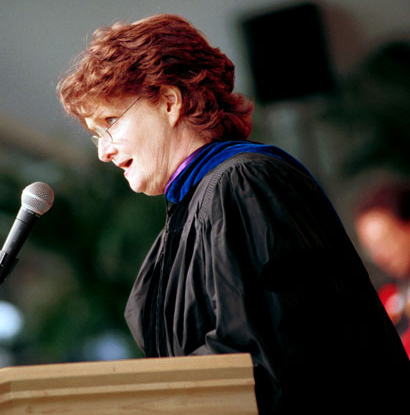Can
language heal grieving? Boland looks for answers
Parents who lost their babies created an outlet
of support
By ERIC WEISSMAN
Grief has nowhere to go when the grieving lack
access to a release valve. Simple language, however, can provide
that release, transforming individuals and institutions along the
way. Eavan Boland discovered this firsthand as poet-in-residence at
the National Republican Hospital in Dublin, Ireland, a decade ago.
She described her experience to a packed house Feb. 11 at Fairchild
Auditorium as the 14th Jonathan J. King lecturer.
Boland, the Bella Mabury and Eloise Mabury Knapp Professor in
Humanities and the director of Stanford’s creative writing
program, delivered a talk titled “The Science of Curing and
the Art of Healing: a Poet’s Experience.” Her
presentation focused on a support group she helped organize for
young parents whose infants had been stillborn or died soon after
birth. Her presentation, like all those in the Center for
Biomedical Ethics-sponsored King series, explored humanity, empathy
and patients’ rights.

Eavan Boland, director of
Stanford’s creative writing program, spoke on medical
compassion. Photo: L.A.
Cicero
“I had no credentials in medicine or science,” Boland
said, recounting her first days in her new role. “The
hospital had sought out the arts and I wanted to explore the common
ground that language provides between the institution and the
individual.” Immediately, the imposing power of the
institution struck Boland – its ability to dwarf the
individual, rendering people faceless, powerless and unheard.
The challenges Boland and the new support group faced were
considerable. In Ireland, the death of an infant traditionally
triggers a reflex of shame and isolation. Up until 1994, the
government didn’t issue official certification of stillborn
infants, as if to negate the existence of a life. In the hospital,
mothers routinely were refused upon asking to see their babies
after they had died.
As a matter of course, stigmatized parents faced prejudice, lacked
organized support outlets and at best were told by doctors and
nurses that they were still young and could try again – words
Boland described as “the most wounding comments.” The
onus of responsibility in the crisis, she said, rested on
embarrassed parents who were pressured to “move tastefully
past the death” without acknowledging its impact. Often, they
were left feeling like they had lost not only their babies but
their communities as well.
The support group corraled a spectrum of individuals across the
social and economic classes in Ireland, each member sharing one
thing in common: the death of a child. “People in the group
wanted very much to name their babies,” Boland said.
“They wanted others not to move past this small life.”
Additionally many of the parents felt shock upon having lost a life
in the precise location where they anticipated life to begin, then
returning alone to homes that had been prepared to welcome a new
life.
Despite the staggering patient volume at the hospital (Boland noted
1 in 12 Irish citizens, including both her daughters, were born
there) the nurses and doctors, like all those in Ireland, were
historically untrained in dealing with an infant’s death from
an emotional perspective. The problem wasn’t a peculiarity
with that one hospital, rather it was a fact of the hospital being
woven into Irish society. But, she said, the times were changing,
both in Ireland in general and at that hospital in particular.
In 1994, the Irish government began issuing certification for
stillbirths. The hospital also launched a far-reaching effort to
accommodate parents, not only by sponsoring the support group and
programs such as the artist-in-residence program but also by
bringing in mortuary services and making its chapel available for
funerals. Mothers were not only permitted to see and name their
babies who had died but families were encouraged to take the babies
home for a day or overnight.
Boland explained that in accepting the poet-in-residence position
she had wanted to explore the power of language within the
institution, particularly how it related to the difference between
curing and healing. “People in my group could not be
cured,” she said, “but could they be healed? That was
the question.”
After recounting one story of a man who drove along a seaside road
with his daughter in the car, knowing that if he could have shown
her one thing while she had been alive, it would have been the
ocean, Boland thought she had her answer. “Language did its
work,” she said. It represented the ideas it was intended to
represent. And most importantly, a human connection was forged
within the institution.

|

